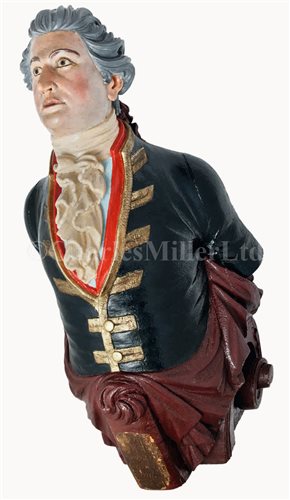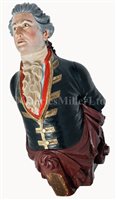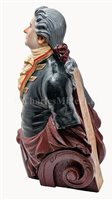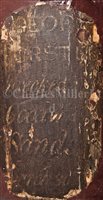3rd Nov, 2015 12:00
Maritime and Scientific Models, Instruments & Art ('Encounter')
127
[M] A FINE FIGUREHEAD RECOVERED DURING THE...
carved from solid elm with laminated arms as a half-length portrait depicting George Forster wearing a braided coat with finely carved jabot and hair, terminating in a scroll, faintly inscribed to front GEORGE / FORSTER / Wrecked on / Goodwin / Sands / March 30th 1830 [sic] -- 50in. (127cm.) high
Provenance: Until recently this figurehead adorned the True Briton public house, Folkestone, where it had resided for an unknown period of time.
The Times for 1st December, 1856 reported the grounding of the Prussian ship George Forster the previous day, 30th November - one of six groundings between September and December that year. At the time it was stated that she was laden with timber and that steam tugs and lifeboats were standing by as it was "feared she would become a wreck". Both her main and mizzen masts had been cut away in an effort to re-float her at the next high tide and it seems highly likely that this figurehead - a weighty adornment when every ounce mattered - was removed at the same time in a last, desperate attempt to save the vessel. In the event it was all in vain as the ship broke her back and became a complete loss, although her crew was entirely saved.
George Forster (1754-94) was born near Danzig in what was then Polish Prussia to a family that had British antecedents. His father Johann, a reluctant cleric, took every opportunity to expand his travel and scientific knowledge and his enthused son soon followed suit. In 1766 the pair travelled to London in search for an appropriate position and, on their arrival, the elder Forster established contact with other German-speaking clergy and intellectuals in London. Among them was Carl Gottfried Woide, the Lutheran preacher and man of letters, who helped them find lodgings in Denmark Street and establish contacts within the British scientific and scholarly communities. In 1772 he was engaged to replace Joseph Banks as naturalist on James Cook's second Voyage of Discovery in the Resolution, and took young George along as his assistant. The voyage took the Forsters round the Cape of Good Hope to New Zealand, Tahiti, Tonga, and south beyond the Antarctic circle. George Forster's later reputation was based largely on the descriptions of the voyage he published after their return in 1775. The first of these was a botanical work, Characteres generum plantarum... MDCCLXXII-MDCCLXXV, published together with his father, which earned him election to the Fellowship of the Royal Society. A Voyage Round the World, in His Britannic Majesty's Sloop, Resolution (1777), which Forster published after his father had been denied the opportunity to write the official account of the voyage, had much greater impact. In 1779 he returned to Germany where he held several academic posts and from April to June 1790 he undertook a further journey, accompanied by Alexander von Humboldt. This time be travelled along the Rhine, through the Low Countries, and on to London, returning through revolutionary France and Forster's account of the journey was held in great esteem by contemporaries. Forster remained in Mainz after the occupation of the city by French revolutionary forces in 1792, becoming active in Jacobin circles. A supporter of the incorporation of the west bank of the Rhine into the French republic, in early 1793 Forster was elected deputy for Mainz to the national convention in Paris. His writings about the revolution were significant, if highly contentious, contributions to its reception in the German-speaking world. He died suddenly in Paris on 10th January, 1794 at the age of 39. It is not surprising that such a famous and significant character was honoured with the name of a ship by his fellow countrymen.
The George Forster figurehead in Perspective
The world of Ships Figureheads can be divided in to roughly four main subject forms: Female, Male, Creatures and Billets-types, each one having a number of subdivisions. Whilst it is no surprise that surviving female figureheads out number males by at least five to one, the vast majority of male figureheads are from unknown vessels, possibly depicting a forgotten vessel's owner or local dignitary; they represent the epitome of late Georgian and early Victorian gentlemen yet, occasionally, a male figurehead survives to show that exceptions to the rule can be found, and the George Forster is one such figurehead. His remarkable state of preservation, due in part to the fact that he has been carved from a solid block of elm, is an indication of high quality coupled with durability. Laminated yellow pine was used for the vast majority of figureheads at this date (around 1830) and was a lighter, less resilient wood, vulnerable to rot and splitting. The use of elm is significant in allowing the carved detail to be as crisp and sharp as the day he was carved. The carver would have relied on pictorial references supplied by the ship's owner, a number of contemporary portraits of both George and his father have survived, plus a number of illustrations published after his death, giving the carver ample reference material to create a portrait carving that has been painted almost to life. Great care and sensitivity has been taken with the face and hair and we see a handsome young man brimming with confidence that belies his tragic death, and particular attention has been made to the delicate and intricate folds of his jabot, while the base has a rich assortment of flowing material culminating in a very finely carved backwards scroll, with acanthus leaves - a true tour de force of the ship carvers skill.
During the conservation work on George Forster the original colour scheme was researched and sensitively re-applied; it's not uncommon for a figurehead of this age to have numerous layers of inapt over-painting by the ship's crew and amateur artists, masking the true detail and appearance. In this instance, an important clue as to identity was found on the front of the figure, painted in gold leaf, in a style of typeface commonly used during the second quarter of the nineteenth century, in larger letters is "GEORGE FORSTER WRECKED ON GOODWIN SANDS" with a date of March 30th 1830. Subsequent research has shown this date to be incorrect and the true date of the wreck, while still on the Goodwin Sands, was in fact 1856 - an error put down to the sign writer. What is not disputed are the facts of the wrecking from the journal of the RNLI and The Times; or the exceptional quality of this carving with a strong provenance rarely seen today in today's market.
Richard Hunter
Figurehead Historian
Sold for £24,800
Estimated at £15,000 - £20,000
(inc. buyer's premium of 24%)
Condition Report
Cleaned and repainted approximately fifteen years ago - pre-restoration photos are available on request. Similar colour scheme adopted, wood appears to be in an excellent state of preservation.
We are pleased to provide you with a general report of the condition of this property. Since we are not professional conservators or restorers, we urge you to consult with a restorer or conservator of your choice who will be better able to provide a detailed, professional report. Prospective buyers should inspect each lot to satisfy themselves as to condition and must understand that any statement made by Charles Miller Ltd is merely a subjective, qualified opinion. Prospective buyers should also refer to any Important Notices regarding this sale, which are printed in the Sale Catalogue. NOTWITHSTANDING THIS REPORT OR ANY DISCUSSIONS CONCERNING A LOT, ALL LOTS ARE OFFERED AND SOLD “AS IS” IN ACCORDANCE WITH THE CONDITIONS OF BUSINESS PRINTED IN THE SALE CATALOGUE.
carved from solid elm with laminated arms as a half-length portrait depicting George Forster wearing a braided coat with finely carved jabot and hair, terminating in a scroll, faintly inscribed to front GEORGE / FORSTER / Wrecked on / Goodwin / Sands / March 30th 1830 [sic] -- 50in. (127cm.) high
Provenance: Until recently this figurehead adorned the True Briton public house, Folkestone, where it had resided for an unknown period of time.
The Times for 1st December, 1856 reported the grounding of the Prussian ship George Forster the previous day, 30th November - one of six groundings between September and December that year. At the time it was stated that she was laden with timber and that steam tugs and lifeboats were standing by as it was "feared she would become a wreck". Both her main and mizzen masts had been cut away in an effort to re-float her at the next high tide and it seems highly likely that this figurehead - a weighty adornment when every ounce mattered - was removed at the same time in a last, desperate attempt to save the vessel. In the event it was all in vain as the ship broke her back and became a complete loss, although her crew was entirely saved.
George Forster (1754-94) was born near Danzig in what was then Polish Prussia to a family that had British antecedents. His father Johann, a reluctant cleric, took every opportunity to expand his travel and scientific knowledge and his enthused son soon followed suit. In 1766 the pair travelled to London in search for an appropriate position and, on their arrival, the elder Forster established contact with other German-speaking clergy and intellectuals in London. Among them was Carl Gottfried Woide, the Lutheran preacher and man of letters, who helped them find lodgings in Denmark Street and establish contacts within the British scientific and scholarly communities. In 1772 he was engaged to replace Joseph Banks as naturalist on James Cook's second Voyage of Discovery in the Resolution, and took young George along as his assistant. The voyage took the Forsters round the Cape of Good Hope to New Zealand, Tahiti, Tonga, and south beyond the Antarctic circle. George Forster's later reputation was based largely on the descriptions of the voyage he published after their return in 1775. The first of these was a botanical work, Characteres generum plantarum... MDCCLXXII-MDCCLXXV, published together with his father, which earned him election to the Fellowship of the Royal Society. A Voyage Round the World, in His Britannic Majesty's Sloop, Resolution (1777), which Forster published after his father had been denied the opportunity to write the official account of the voyage, had much greater impact. In 1779 he returned to Germany where he held several academic posts and from April to June 1790 he undertook a further journey, accompanied by Alexander von Humboldt. This time be travelled along the Rhine, through the Low Countries, and on to London, returning through revolutionary France and Forster's account of the journey was held in great esteem by contemporaries. Forster remained in Mainz after the occupation of the city by French revolutionary forces in 1792, becoming active in Jacobin circles. A supporter of the incorporation of the west bank of the Rhine into the French republic, in early 1793 Forster was elected deputy for Mainz to the national convention in Paris. His writings about the revolution were significant, if highly contentious, contributions to its reception in the German-speaking world. He died suddenly in Paris on 10th January, 1794 at the age of 39. It is not surprising that such a famous and significant character was honoured with the name of a ship by his fellow countrymen.
The George Forster figurehead in Perspective
The world of Ships Figureheads can be divided in to roughly four main subject forms: Female, Male, Creatures and Billets-types, each one having a number of subdivisions. Whilst it is no surprise that surviving female figureheads out number males by at least five to one, the vast majority of male figureheads are from unknown vessels, possibly depicting a forgotten vessel's owner or local dignitary; they represent the epitome of late Georgian and early Victorian gentlemen yet, occasionally, a male figurehead survives to show that exceptions to the rule can be found, and the George Forster is one such figurehead. His remarkable state of preservation, due in part to the fact that he has been carved from a solid block of elm, is an indication of high quality coupled with durability. Laminated yellow pine was used for the vast majority of figureheads at this date (around 1830) and was a lighter, less resilient wood, vulnerable to rot and splitting. The use of elm is significant in allowing the carved detail to be as crisp and sharp as the day he was carved. The carver would have relied on pictorial references supplied by the ship's owner, a number of contemporary portraits of both George and his father have survived, plus a number of illustrations published after his death, giving the carver ample reference material to create a portrait carving that has been painted almost to life. Great care and sensitivity has been taken with the face and hair and we see a handsome young man brimming with confidence that belies his tragic death, and particular attention has been made to the delicate and intricate folds of his jabot, while the base has a rich assortment of flowing material culminating in a very finely carved backwards scroll, with acanthus leaves - a true tour de force of the ship carvers skill.
During the conservation work on George Forster the original colour scheme was researched and sensitively re-applied; it's not uncommon for a figurehead of this age to have numerous layers of inapt over-painting by the ship's crew and amateur artists, masking the true detail and appearance. In this instance, an important clue as to identity was found on the front of the figure, painted in gold leaf, in a style of typeface commonly used during the second quarter of the nineteenth century, in larger letters is "GEORGE FORSTER WRECKED ON GOODWIN SANDS" with a date of March 30th 1830. Subsequent research has shown this date to be incorrect and the true date of the wreck, while still on the Goodwin Sands, was in fact 1856 - an error put down to the sign writer. What is not disputed are the facts of the wrecking from the journal of the RNLI and The Times; or the exceptional quality of this carving with a strong provenance rarely seen today in today's market.
Richard Hunter
Figurehead Historian
Auction: Maritime and Scientific Models, Instruments & Art ('Encounter'), 3rd Nov, 2015



